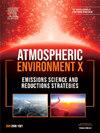室内建筑环境中粒子暴露和低成本传感器性能的任务特定评估
IF 3.4
Q2 ENVIRONMENTAL SCIENCES
引用次数: 0
摘要
在本研究中,在两套公寓的室内装修过程中,进行了一项工作场所测量活动,包括面板拆除、墙纸拆除(干/湿)、扫地(干/湿)和地板拆除(包括隔热层)任务。使用低成本传感器(LCS)进行测量;OPC-N3;将Alphasense)与基准光学粒度仪(OPS, TSI Model 3330)进行比较,以评估该LCS在建筑工人环境中的适用性。此外,使用迁移度粒度仪(nanscan, TSI Model 3091)和扩散粒度仪(DiSCmini)测量超细颗粒浓度(<0.1 μm)。颗粒数浓度(PNC)最高的是在地板清理、干扫和墙纸清理过程中,其中63%的颗粒是超细(0.1 μm), 96%的颗粒小于2.5 μm (PM2.5)。在某些作业中测量到的PM10(直径为10 μm的颗粒物)浓度超过了总粉尘(0.3 ~ 11 mg m−3)10 mg m−3的职业暴露限值。分析电子显微镜分析显示暴露于化合物,如滑石粉,二氧化钛,石英,和潜在的石棉。水基粉尘控制方法减少了至少84%的PNC,突出了它们在减轻暴露方面的有效性。LCS普遍低估了颗粒物浓度,特别是PM1,其被低估的幅度在31%至92%之间。最大的差异发生在高浓度超细颗粒存在的情况下,例如地板去除和干燥墙纸去除。本研究还强调了多尺度测量和呼吸区评估对准确评估工人暴露和提高职业安全的重要性。本文章由计算机程序翻译,如有差异,请以英文原文为准。

Task specific assessment of particle exposure and low-cost sensor performance in indoor construction environments
In this study, a workplace measurement campaign was conducted during indoor renovation of two apartments following panel removal, wallpaper removal (dry/wet), sweeping (dry/wet), and floor removal (including insulation) tasks. Measurements with a low-cost sensor (LCS; OPC-N3; Alphasense) was compared to a benchmark optical particle sizer (OPS, TSI Model 3330) to assess the applicability of this LCS in a construction worker environment. Additionally, ultrafine particle concentrations (<0.1 μm) were measured using a mobility particle sizer (NanoScan, TSI Model 3091) and a diffusion size classifier (DiSCmini).
The highest particle number concentrations (PNC) were found during floor removal, dry sweeping, and wallpaper removal, where 63 % of particles were ultrafine (<0.1 μm) and 96 % were smaller than 2.5 μm (PM2.5). The PM10 (particulate matter with a diameter <10 μm) concentrations measured during some tasks exceeded the occupational exposure limit of 10 mg m−3 for total dust with values from 0.3 to 11 mg m−3. Analytical electron microscopy analysis revealed exposure to compounds such as talc, titania, quartz, and potential asbestos. Water-based dust control methods reduced PNC by at least 84 %, highlighting their effectiveness in mitigating exposure. LCS generally underestimated particle concentrations, particularly for PM1, which was underestimated ranging from 31 % to 92 %. The largest discrepancies occurred during high concentrations in the presence of ultrafine particles, such as floor removal and dry wallpaper removal. This study also emphasizes the importance of multi-metric measurements and breathing zone assessments to accurately evaluate worker exposure and improve occupational safety.
求助全文
通过发布文献求助,成功后即可免费获取论文全文。
去求助
来源期刊

Atmospheric Environment: X
Environmental Science-Environmental Science (all)
CiteScore
8.00
自引率
0.00%
发文量
47
审稿时长
12 weeks
 求助内容:
求助内容: 应助结果提醒方式:
应助结果提醒方式:


